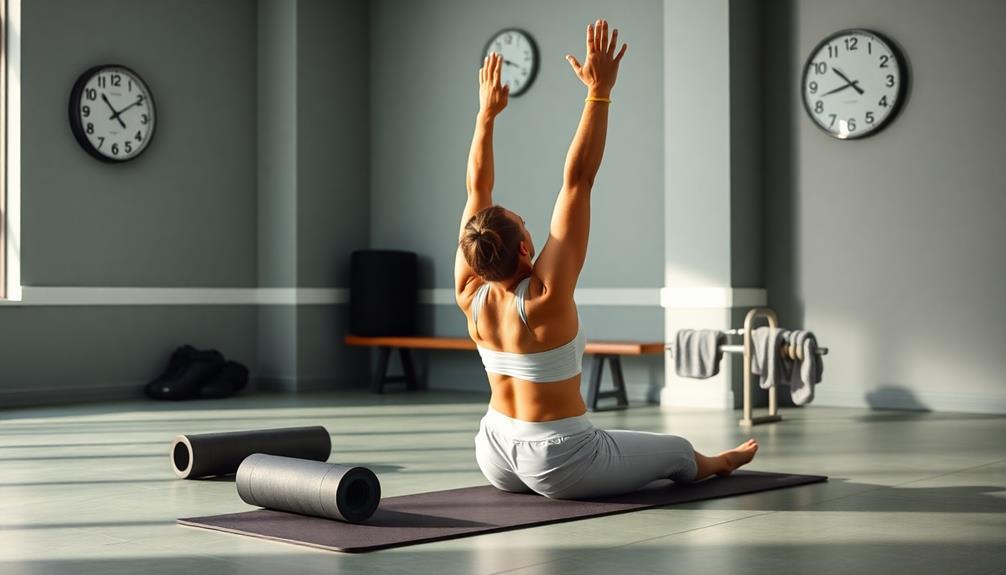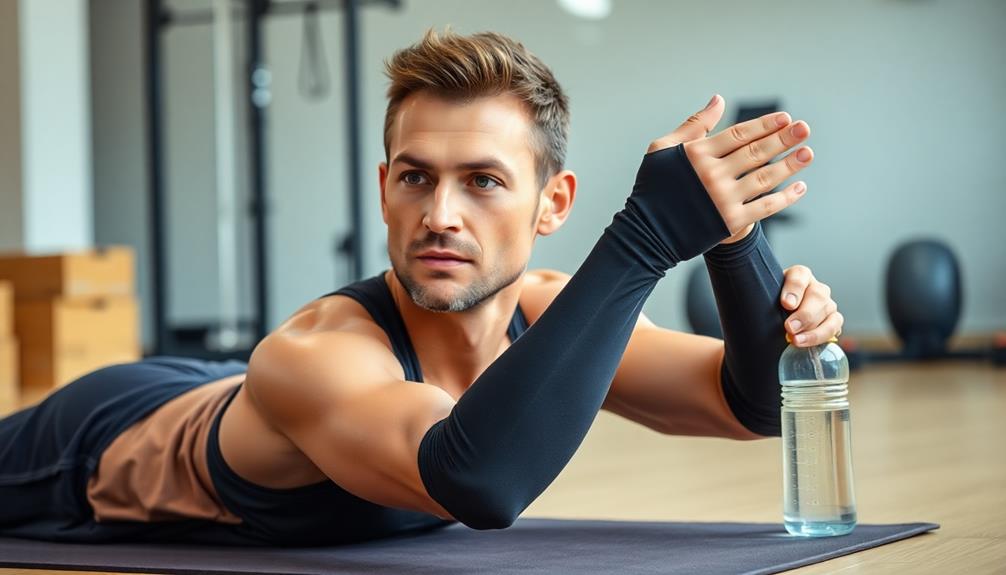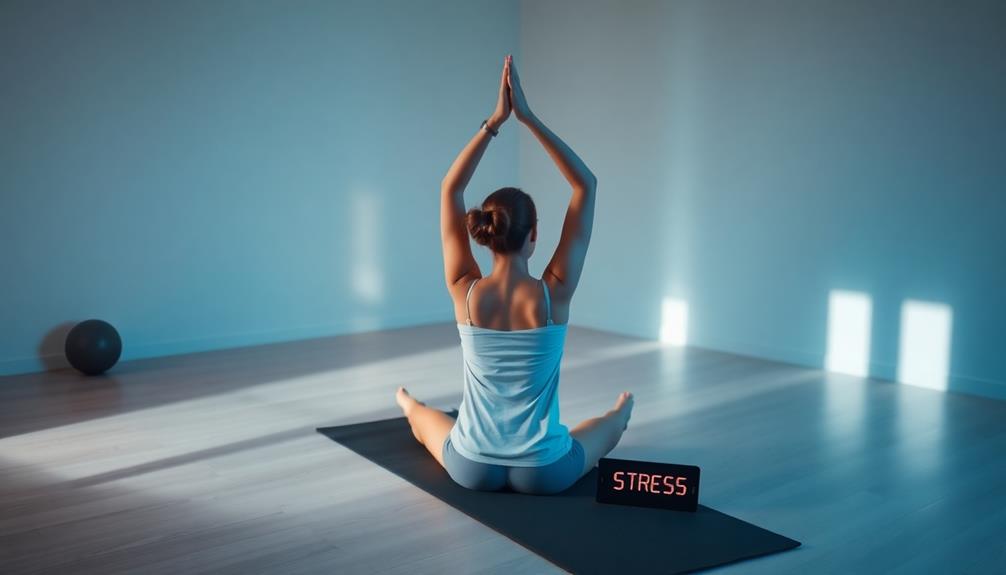To optimize your post-workout recovery, focus on these essential strategies: hydrate properly, stretch and cool down, refuel with balanced nutrition, and get adequate sleep. Incorporate foam rolling techniques to alleviate muscle tension, and practice active recovery on rest days. Utilize compression gear to improve circulation, and consider massage therapy for enhanced muscle repair. Don't forget to manage stress levels, as this can greatly impact your body's ability to recover. Also, maintain proper form during workouts to prevent unnecessary strain. By implementing these strategies, you'll set yourself up for better performance and reduced risk of injury. Let's explore each of these tactics in more detail.
Core Insight
- Rehydrate with water or electrolyte-rich beverages to replenish fluids lost during exercise.
- Perform a proper cool-down routine including light cardio and stretching to prevent muscle soreness.
- Consume a balanced meal with protein and carbohydrates within an hour post-workout for muscle repair.
- Prioritize 7-9 hours of quality sleep nightly to promote muscle recovery and overall health.
- Use foam rolling techniques to alleviate muscle tension and improve flexibility post-exercise.
Hydrate Properly

Drinking water is crucial after a tough workout. You lose fluids when you sweat, so you need to replace them. Try to drink at least 16-20 ounces of water within 30 minutes of finishing your workout. If you had an intense session or exercised in the heat, you might need to drink even more. For the best hydration, think about drinking coconut water. It has a lot of natural electrolytes and potassium, which can help you recover faster and replace lost nutrients.
Don't just rely on being thirsty to know when to drink. It's not always accurate. Instead, check the color of your urine. If it's light yellow, you're well-hydrated. If it's darker, you need to drink more fluids. For longer workouts that last over an hour, consider sports drinks. They can help replace the sodium and potassium you lose through sweat, helping you recover faster.
Stretch and Cool Down

Don't skip cooling down after your workout. It's important for lowering your heart rate slowly and stopping blood from pooling in your muscles. Start with 5-10 minutes of light cardio, like walking or jogging at a slow pace.
Then, stretch your muscles. Hold each stretch for 15-30 seconds, focusing on the main muscle groups you worked. This improves flexibility and reduces muscle tension. Make sure to stretch areas that get tight easily, like your hamstrings, quadriceps, and lower back. To help your muscles recover and relax even more, try using a foam roller after your workout.
Include some dynamic stretches to keep your muscles elastic. Gentle arm circles, leg swings, and twists can help. Remember to breathe deeply and relax into each stretch.
Cooling down properly can help reduce soreness after your workout and speed up recovery. It's an essential part of your fitness routine, so take your time and do it right.
Refuel With Balanced Nutrition

Refuel your body with a balanced meal or snack within an hour after an intense workout. This helps your muscles repair and grow while restoring energy levels. Choose foods that have both protein and carbs, such as:
- Chicken, fish, or plant-based proteins
- Whole grains like rice or quinoa
- Starchy vegetables like sweet potatoes
- Fruits for vitamins and minerals
To quickly replenish energy, mix a fast-acting carbohydrate powder into a protein shake or water. This makes it easy to get the nutrients your body needs right away.
Don't forget to drink plenty of water or an electrolyte beverage. Proper hydration replaces fluids lost through sweat. If you have another workout coming up soon, a protein shake with added carbs can help you recover faster.
Get Adequate Sleep

Sleep is just as important as eating well for recovering after a workout. When you sleep, your body fixes itself and grows, which helps your muscles get bigger and makes you more fit overall. Try to get 7-9 hours of good sleep every night so your body can recover as much as possible. If you need help falling asleep, you can try taking melatonin pills or drinking herbal tea.
To sleep better and recover more after exercising:
- Go to bed and wake up at the same times every day
- Do relaxing things before bed to help you unwind
- Make sure your bedroom is cool, dark, and quiet
Use Foam Rolling Techniques

Foam rolling is a great way to help your muscles recover after a workout. It's a type of self-massage that targets specific muscle groups to relieve tension and soreness. To get started, you'll need a foam roller. Set aside 10-15 minutes after your workout to roll out your muscles.
Start with big muscle groups like your back, glutes, and quads. Roll slowly over each area, pausing on sore spots for 20-30 seconds. Use gentle pressure at first, then press harder as your muscles relax. Don't forget smaller muscles like calves and IT bands.
Make foam rolling part of your regular cool-down routine after every workout. It can improve flexibility, reduce soreness, and help you recover faster. Stay hydrated and listen to your body. Avoid pressing too hard on sensitive areas.
Take Ice Baths

Ice baths can help you recover after tough workouts. The cold water reduces swelling, muscle pain, and tiredness. When you get in cold water, your blood vessels get smaller and your body slows down, which might help you feel better faster.
Here's how to take an ice bath the right way:
- Fill a bathtub with cold water (50-59°F or 10-15°C)
- Get in the water so it covers you up to your neck
- Stay in for 10-15 minutes
- Take deep breaths and try to relax even though it's cold
Ice baths aren't for everyone. If you have heart problems or are pregnant, talk to your doctor first. Pay attention to how your body feels and slowly stay in longer over time. Ice baths are just one way to recover, so use them along with other methods to feel your best.
Practice Active Recovery

Active recovery helps your body feel better after hard workouts. It means doing easy exercises that get your blood moving and make your muscles less sore. You can try things like:
- Going for a light jog or easy bike ride
- Swimming at a relaxed pace
- Stretching gently or doing yoga
- Using a foam roller to massage tight muscles
- Playing sports like basketball or tennis, but not too intensely
These activities bring fresh blood to your muscles and help get rid of lactic acid that makes you feel sore. They also improve your flexibility and help you relax. So next time you finish a tough workout, remember that staying active with easy exercises is a great way to recover faster and feel better.
Utilize Compression Gear

Wearing special compression clothing after your workout can speed up recovery by increasing blood flow and easing muscle soreness. Using tools to massage your muscles can boost the effects of compression gear, helping you target specific areas. Look for compression gear made for different parts of your body:
- Socks or sleeves for your legs
- Shorts or tights for your lower body
- Shirts or arm sleeves for your upper body
Putting on compression clothing right after exercise helps reduce muscle swelling and tiredness. The light squeezing from these garments also pushes out waste products from your muscles. For the best results, wear your compression gear for at least one hour after your workout. You can even sleep in it to get extra benefits while you rest.
Try Massage Therapy

Massage therapy is a powerful recovery tool, not just a luxury. It can help your muscles bounce back faster and better after workouts. Massage has many benefits:
- Eases muscle soreness
- Boosts blood flow
- Reduces inflammation
- Improves flexibility
- Helps you relax
To add massage to your routine:
- Book regular appointments with a massage therapist
- Do self-massage at home
- Use a foam roller or massage gun
The best times to get a massage are:
- Right after tough workouts
- During rest days
- Before important competitions or events
For even more relief, pair massage with cooling gel packs. These handy tools provide both heat and cold therapy to further reduce inflammation and soothe achy muscles.
Manage Stress Levels

Managing stress is just as important for recovery as physical therapies like massage. Too much stress can make it harder for your body to repair and rebuild muscle, which might undo the good of your workout. Supplements called adaptogens can help balance stress hormones and improve how well you handle stress. To keep stress under control and help your body recover, try adding these things to your routine:
- Take 10-15 minutes each day to practice mindfulness or meditation
- Aim to get 7-9 hours of good quality sleep every night
- Make time for relaxing activities you enjoy, like reading or gentle yoga
Frequently Asked Questions
How Long Should I Wait Before Working Out the Same Muscle Group Again?
You should generally wait 48-72 hours before working out the same muscle group again. This allows for proper recovery and muscle growth. However, your specific wait time may vary depending on your fitness level and workout intensity.
Can Overtraining Negatively Impact My Recovery and Progress?
Yes, overtraining can definitely harm your recovery and progress. You'll experience fatigue, decreased performance, and increased injury risk. Your muscles won't have time to repair, leading to plateau or even regression in your fitness gains. It's essential to balance workouts with rest.
Are Supplements Necessary for Optimal Post-Workout Recovery?
While supplements can be helpful, they're not necessary for best post-workout recovery. You can achieve great results with proper nutrition, hydration, and rest. Focus on whole foods and listen to your body's needs for effective recovery.
How Do I Know if I'm Recovering Properly or Need More Rest?
You'll know you're recovering properly if you're not feeling excessive soreness or fatigue. Listen to your body. If you're constantly tired, experiencing decreased performance, or getting injured, you might need more rest between workouts.
What's the Ideal Workout-To-Rest Ratio for Different Types of Exercise Routines?
You'll need different rest ratios depending on your workout type. For strength training, aim for 1-2 rest days between sessions. Cardio allows for more frequent workouts, but still include 1-2 rest days weekly. Listen to your body's signals.

